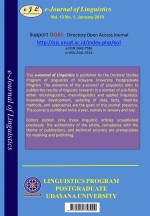Argument Structure of Slide Verb in English
Abstract
Various languages in the world have their own systems, especially in terms of verb classification. It can determine argument in the structure. This paper is intended to analyze the interaction between syntax and semantics in terms of the argument structure of the slide verb in English. The main theory used in this study was the theory of argument structure proposed by Kim & Sells (2008). The result of analysis showed that two kinds of slide verb: bounce and slide are intransitive and transitive verbs. The specifier (SPR) of the sentence structure functions as the agent; the Complement (COMPS) of the verb bounce serves as the patient and the COMPS of the verb slide functions as the theme.
Downloads
References
Hornby, A.S. 2010. Oxford Advanced Learner’s Dictionary Eighth Edition. Oxford: Oxford University Press.
Kim, Jong-Bok and Sells, Peter. 2008. English Syntax: An Introduction. Stanford: CSLI Publications.
Levin, Beth. 1955. English Verb Classes and Alternations. London: The University of Chicago Press.
Masreng, Robert, et al. CAUSATIVITY AND ALTERNATION ME-KAN / -I IN INDONESIAN. e-Journal of Linguistics, [S.l.], p. 32—42, jan. 2019. ISSN 2541-5514. Available at:
Richards, et al. 1985. Longman Dictionary of Applied Linguistics. England: Longman.
Utami, Ni Made Verayanti, et al. THE ANALYSIS OF INDONESIAN TRANSITIVE AND INTRANSITIVE VERBS FOUND IN THE TRANSLATION OF POSSUM MAGIC – AN AUSTRALIAN CLASSIC BY BIPA STUDENTS OF LA DENPASAR. e-Journal of Linguistics, [S.l.], p. 79--87, july 2018. ISSN 2541-5514. Available at:
Varga, László. 2010. Introduction to English Linguistics: A Companion to the Seminar. Budapest: Eötvös Loránd University.

This work is licensed under a Creative Commons Attribution 4.0 International License.

This work is licensed under a Creative Commons Attribution 4.0 International License











